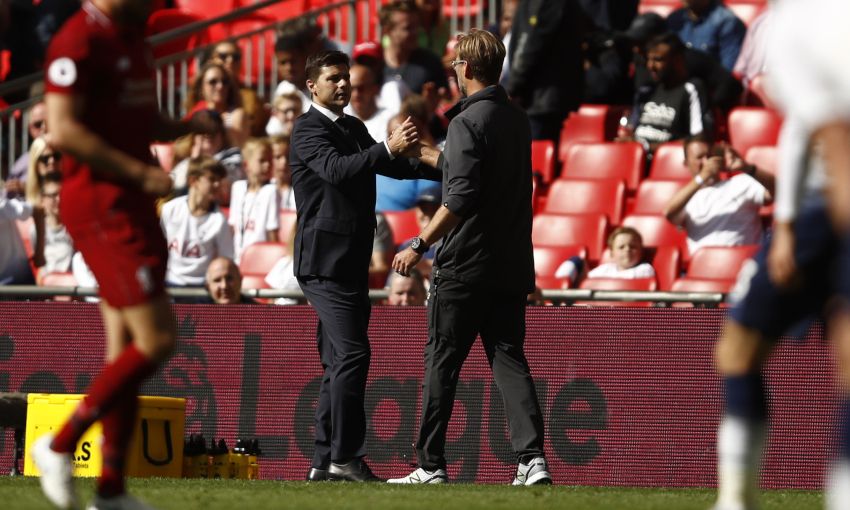Champions League final: Jonathan Wilson's tactical preview
The good news for Liverpool fans is that, of nine previous meetings between Jürgen Klopp and Mauricio Pochettino, their man has come out on top four times, with four draws.
The most emphatic of those victories, at least in terms of performance, probably came at Wembley this season with a 2-1 win that was far more dominant than that scoreline may suggest. The slightly more troubling news is that only one of those four wins has been by more than a single goal and that the most recent game, Liverpool’s 2-1 victory at Anfield at the end of March, was as tight as could be.
Although Liverpool bossed the first half of that game, Tottenham came back strongly in the second, levelled the score at 1-1 and might have taken the lead when Moussa Sissoko ran though, only to be forced by some excellent defending from Virgil van Dijk into shooting with his weaker foot when he might have slipped a pass through to Son Heung-min. Liverpool won in the end thanks to a Hugo Lloris error leading to Toby Alderweireld’s late own goal. That has tended to be the way of things in recent meetings between the sides: tight, high-tempo, high-quality games that have been settled by a moment of individual excellence or a mistake.
Tactically, the discussion is dominated by questions about Spurs, if only because Pochettino is so much more inclined to change formation. It would be something extraordinary if Klopp does not go in with a 4-3-3 and, even within that, the only slight debate is about the make-up of the midfield three. Pochettino, though, is much more inclined to make changes, even within games.
In part, particularly in the latter stages of this season, that’s been because of a lengthy injury list (to an extent, the back three Spurs deployed away to Ajax was less a tactical selection than just who was available) but it’s also a matter of choice. The league game at Anfield this season is revealing in that regard.
Spurs began with a back three. The logic, presumably, was twofold. Firstly, that by doing so Spurs could free up an extra man to press high and so perhaps shift the focus of the game up the pitch. And secondly, to engage Liverpool’s wide forwards high with their wing-backs, with the security of flanking centre-backs behind should Mohamed Salah or Sadio Mane get beyond the wing-back and drift inside. In addition, Kieran Trippier and Danny Rose could in theory have presented an attacking threat, driving beyond Salah and Mane, creating a problem for the two Liverpool full-backs, who would have to decide whether to advance to engage them (very much the default with Trent Alexander-Arnold and Andy Robertson) or whether that risked leaving space for the Spurs front two, in that case Harry Kane and Lucas Moura, to run into.
As it turned out, if that was the thinking, it didn’t work, and Liverpool for an hour or so ran midfield. The balance of the game changed, though, after Son came on for Davinson Sanchez and Spurs went to a back four. The evidence of that match would suggest a 4-2-3-1 in Madrid – although a lot depends on Kane’s fitness.
Average positions: Liverpool v Tottenham, March 2019
If he is fit enough to start, the man to miss out, slightly oddly given he scored a second half-hat-trick in Amsterdam, would presumably be Moura, unless Pochettino takes the very bold decision to use Christian Eriksen as one of his deep-lying midfielders. More likely, though, Eriksen operates on the right with Son on the left (if Kane isn’t fit, he will probably play through the middle with Lucas to the left) and Dele Alli as the central creator in front of Sissoko and, if fit, Harry Winks.
The effect of that is that the formations match up, given that the major difference between a 4-3-3 and a 4-2-3-1 is that the former features one deep central midfielder and, at least in Liverpool’s conception, two more adventurous ones, while a 4-2-3-1 has two deep and one more advanced. Although modern systematised football means games are never just a series of head-to-heads, that does produce a number of intriguing individual battles.
Alli has had a stop-start season but found form in the final month of the campaign: his lay-off to Lucas was a vital part of that late winner against Ajax. His tussle with Fabinho will be key. Even more important, though, is likely to be the skirmishes on the flanks, with both sides featuring attacking full-backs and at least one wide forward who is perhaps not overly keen on the defensive side of the game: Alexander-Arnold plus Salah against Rose plus Son on one side, and Robertson plus Mane against Trippier plus (probably) Eriksen on the other.
More generally, although Pochettino and Klopp had very different footballing educations, their essential philosophies are very similar. Both press hard and high, both combine a belief in the value of the system with a sense that the system must allow individuals to express themselves and that character is vital. In that, perhaps surprisingly, both have a view of football not that far removed from the style that predominated in the English game in the late 1970s and early ‘80s. Both have extremely technically gifted players, both are clearly tactically astute, but neither is afraid to stress the value of pace, power and commitment.

These are two teams with very little between them – Liverpool probably do have an edge but not as much as the 26-point gap in the league might suggest. From a tactical point of view, it will be Spurs looking to adapt to Liverpool. But from a wider angle, the final is an expression of the best traditions of English football, repackaged and repurposed for the modern age.



